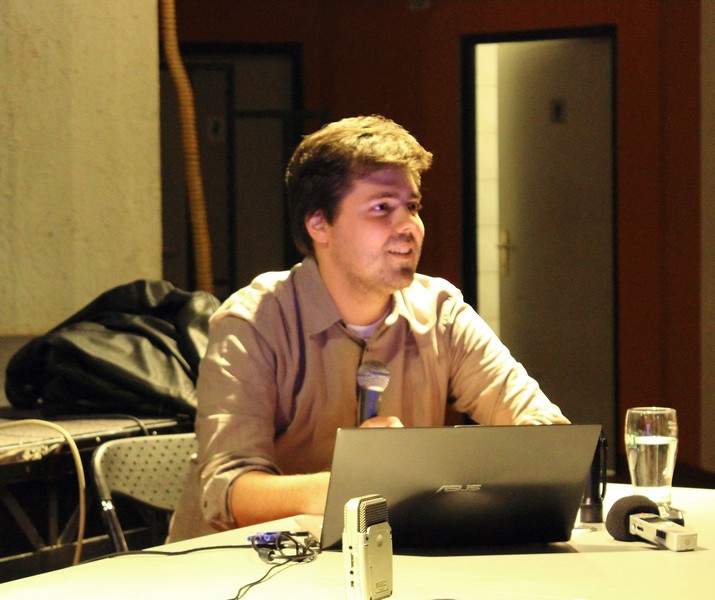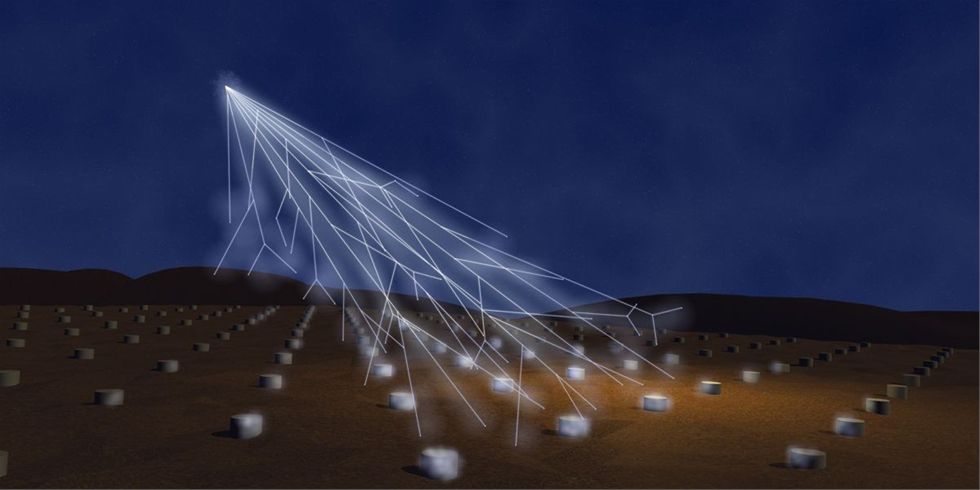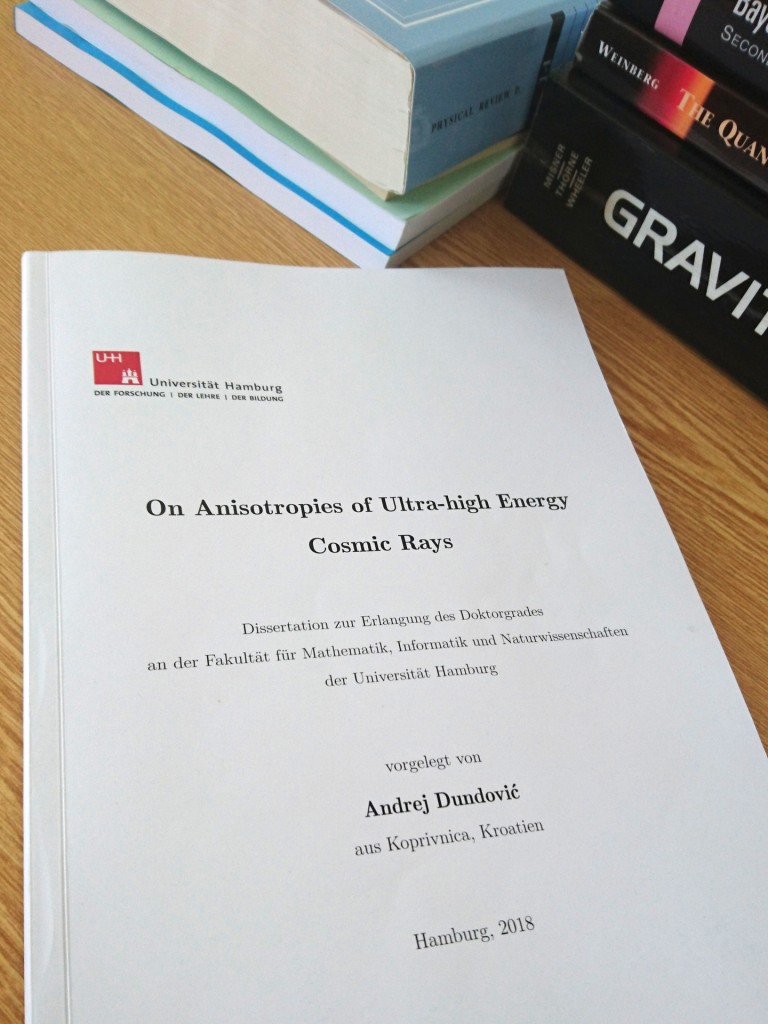 U ponedjeljak je na njemačkom Sveučilištu u Hamburgu održana obrana doktorske disertacije Andreja Dundovića s naslovom “On Anisotropies of Ultra-high Energy Cosmic Rays” (O anizotropijama visoko-energetskih kozmičkih zraka / Über Anisotropien der ultrahochenergetischen kosmischen Strahlung). Pod mentorstvom prof.dr. Güntera Sigla i komentorstvom prof.dr. Dietera Hornsa, ovaj tridesetogodišnji Križevčanin je u dvosatnom izlaganju obranio vlastiti izvorni znanstveni doprinos iz područja teorijske astrofizike.
U ponedjeljak je na njemačkom Sveučilištu u Hamburgu održana obrana doktorske disertacije Andreja Dundovića s naslovom “On Anisotropies of Ultra-high Energy Cosmic Rays” (O anizotropijama visoko-energetskih kozmičkih zraka / Über Anisotropien der ultrahochenergetischen kosmischen Strahlung). Pod mentorstvom prof.dr. Güntera Sigla i komentorstvom prof.dr. Dietera Hornsa, ovaj tridesetogodišnji Križevčanin je u dvosatnom izlaganju obranio vlastiti izvorni znanstveni doprinos iz područja teorijske astrofizike.
Dundović je na svom doktoratu radio kao znanstveni novak na Sveučilištu u Hamburgu, točnije u sklopu II. Instituta za teorijsku fiziku i DESY-ja, najvećeg njemačkog istraživačkoga centra za akceleratorsku i visokoenergetsku fiziku. Član je i međunarodne kolaboracije Pierre Auger Observatory koja se bavi detekcijom visokoenergetskih kozmičkih zraka koristeći opservatorij u Argentini podno Anda, gdje je u dva navrata obavljao terenski dio svog istraživanja.
Fiziku je diplomirao 2013. na Prirodoslovno-matematičkom fakultetu Sveučilišta u Zagrebu s temom diplomskog rada iz fundacija kvantne mehanike, a pod svoje interese unutar fizike ubraja i astrofiziku te kozmologiju. Pored fizike, uključen je i u projekte slobodnog softvera te projekte lokalnih građanskih udruga, pa je tako vrlo aktivan u križevačkim udrugama P.O.I.N.T. i Perzeidi. U Križevcima je završio prirodoslovno-matematički smjer Gimnazije Ivana Zakmardija Dijankovečkoga te osnovnu Glazbenu školu Albert Štriga.
 Sažetak disertacije na engleskom jeziku
Sažetak disertacije na engleskom jeziku
This dissertation deals with the influence of cosmic ray source distributions and cosmic magnetic fields on anisotropies in the arrival directions with a focus on the ultra-high energy range. Two main investigations regarding the subject are presented and one side topic important for the first two.
The first topic is the study of anisotropies caused by a single source where the rest of sources are contributing only isotropically. The cosmic ray flux is affected by a turbulent magnetic field which spreads the arrival directions, and that spread is modelled with a Fisher distribution. The model is then constrained against measurements of the Pierre Auger Observatory, especially against its dipolar anisotropy. Under the small angle approximation, this gives the root mean square angular deflection with respect to the line of sight of 50 +11/-10 degrees. It is shown that the angular deflection would be even greater if particles were crossing different domains of a structured magnetic field. When applying this to two potential nearby sources, Cen A and the Virgo cluster, estimates between the coherence length and field strength are obtained for the intervening turbulent magnetic field.
In the second topic, effects of magnetic fields on anisotropies are considered by inspecting the applicability of Liouville’s theorem on cosmic ray anisotropies. The concept of trapping was identified as a potential cause of anisotropies, and one case of its application is demonstrated. It is shown how the trapping in a structured field can generate a dipolar anisotropy.
The side topic explores the transition from the rectilinear to diffusive propagation where a precise criterion is derived for the case of a turbulent magnetic field.
 Sažetak disertacije na njemačkom jeziku
Sažetak disertacije na njemačkom jeziku
Diese Dissertation behandelt den Einfluß der Verteilung der Quellen kosmischer Strahlung sowie der kosmischen Magnetfelder auf die Anisotropie von Einfallsrichtungen kosmischer Strahlung mit Fokus auf ultra-hohe Energien. Präsentiert werden die zwei hauptsächlichen Untersuchungen dieses Sachverhalts sowie eine Nebenthematik, welche für diese beiden wichtig ist.
Der erste Themenbereich befasst sich mit der Anisotropie verursacht durch eine einzige Quelle, wobei der Beitrag aller anderen Quellen als isotrop angenommen wird. Der Fluss kosmischer Strahlung wird beeinflusst von turbulenten Magnetfeldern, welche die Einfallsrichtungen zerstreuen. Diese Zerstreuung wird mit einer Fisher Distribution nachgestellt. Dieses Modell wird dann eingeschränkt durch Vergleich mit Messungen des Pierre Auger Observatoriums, insbesondere der beobachteten dipolaren Anisotropie. Mit der Kleinwinkelnäherung ergibt sich der quadratische Mittelwert des Ablenkungswinkels zur Sichtlinie zu 50 +11/-10 Grad. Es wird gezeigt, dass der Ablenkungswinkel noch größ er wäre, falls die Teilchen verschiedene Gebiete eines strukturierten Feldes passieren würden. Die Anwendung dessen auf zwei potenzielle Quellen, Cen A und das Virga Cluster, liefert eine Abschätzung der Kohärenzlänge und Feldstärke des dazwischenliegenden tubulenten Magnetfeldes.
Der zweite Themenbereich behandelt die Auswirkung von Magnetfeldern auf Anisotropien indem es die Anwendbarkeit von Liouville’s Theorem auf kosmische Strahlung untersucht. Das Konzept des Einfangens kosmischer Strahlung wurde herausgestellt als eine potenzielle Ursache von Anisotropien und ein Beispiel dessen Anwendung wird demonstriert. Das Einfangen in einem strukturierten feld kann dipolare Anisotropien hervorrufen.
Das Nebenthema erforscht den Übergang von geradliniger zu diffusiver Propagation und leitet ein präzises Kriterium für den Fall turbulenter Magnetfelder ab.



Iskrene čestitke! Osobito me veseli uspjeh mladih nada! Bravo!
Bravo, čestitke, impresivno!!
Liepo je pročitati ovako pozitvan put našeg sugrđanina Dundovića!
Veseli znati i da je i naša gomnazija dala dobre temelje, a isto tako i Prirodoslovno- matematički fakultet u Zagrebu.
No opet je SVE u našim rukama, jer bez našeg sudjelovanja- zalaganja i postavljenih ciljeva ništa od svega.
Doktoru Dundoviću, želim puno uspjeha u radu i životu!
Bravo, čestitke mladom znanstveniku iz Križevaca